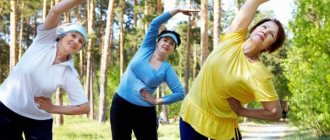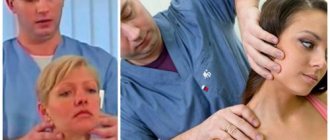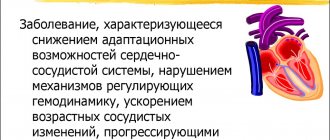Light breathing exercises
Breathing exercises to lower blood pressure help almost all hypertensive patients; it can saturate the body with oxygen, strengthens the heart and vascular system, and can speed up metabolic processes in the body.
If your blood pressure starts to rise, doctors recommend starting with simple activities:
Take a big breath and hold your breath for 15 seconds.- Exhale slowly.
- After 30 seconds, repeat, but hold your breath 5 seconds longer each time.
- Do about 10 repetitions.
Such exercises should be combined with exercises to normalize the condition and reduce blood pressure. In a simplified version of gymnastics, you need to take a lot of breaths. The start of therapy is 10 minutes, 80 breaths are taken. After a few days, you need to increase the number of breaths and time. After 60 days there should be about 5000 breaths per hour. This complex should be carried out 2 times a day.
Exercises according to Strelnikova
Strelnikova’s course helped many hypertensive patients to steadily reduce and normalize blood pressure. All types must be done from a standing position and performed in turn. Repeat each exercise about 6-8 times, but over time the number should increase.
During all movements, breathing should be sharp, and also include many short inhalations and long exhalations.
The full course for hypertension is as follows:
Palms. You need to spread your arms to the sides, bend them so that they are vertical to the floor, and turn your palms away from you. Clench your fists while taking strong but small breaths. Take one big exhale and repeat the exercise up to 6 times. A pause is made for 10 seconds and everything is repeated up to 8 times.- Shoulder straps. Bend your arms at the waist, clench your palms into fists. Taking a strong breath, lower your arms down and unclench your palms with your fingers spread as far apart as possible. Do 8 repetitions without rest, then pause for 10 seconds. Number of approaches up to 8 times.
- Pump. Relax your arms and shoulders, lower them to the floor as much as possible. Bend slowly down and inhale with a sound, and then exhale and straighten up. Repeat 12 times, rest for 5 seconds.
- Hug your shoulders. Bend your arms in front of you, make a lock, your right palm should be directed towards the floor and located under your left elbow. While inhaling quickly, hug yourself, exhale calmly and take the starting position. Repeat 8 times for 9 approaches with an interval of 10 seconds.
- Turn your head. You need to turn your head to the sides, while sharply inhaling air. You can exhale arbitrarily with your mouth open. The exercise involves 8 repetitions with 12 approaches for each side with an interval of 4 seconds.
- Pendulum. Take the bottom position from the “Pump” exercise and do the “Hug your shoulders”. Repeat 8 times for 8 approaches, at intervals of 10 seconds.
By doing the described exercises for hypertension every day, you can ensure that high blood pressure levels decrease. Results appear within a week of the complex.
Exercises according to Bubnovsky
This type of exercise is suitable for lowering blood pressure at home. Starting position - on all fours, resting on your palms and knees. You need to bend your back.
The rest of the set of exercises is carried out from the described position:
- You need to sit on your left leg, bending it, and pull your right leg back. The left leg is extended as far forward as possible so that the body lowers closer to the floor. During movements, you need to include your right hand on your left leg, then vice versa. Inhalations are carried out at the last points. 20 movements are performed at a time.
- It is necessary to stretch your back, but the starting position should be on your elbows, not your palms. As you exhale, lower your body to the floor, while inhaling, straighten your arms, trying to stand on your heels. Exercise reduces blood pressure and strengthens the muscles of the back and lower back. The number of repetitions should be 6 times.
You cannot rely solely on the described complex for hypertension. In severe cases, you cannot do without pills, so the doctor’s advice should not be neglected.
- Therapeutic gymnastics by Evdokimenko for hip joints: video exercises
Exercises according to Buteyko
This complex is also based on breathing exercises; the essence is to use 3 basic exercises, which should be alternated between dynamic and calm ones:
- Hold the breath. The essence of the exercise is an artificial lack of air. The breath is held for 10 seconds, after which small breaths are taken for 1-2 minutes.
- Hold your breath while walking. It is necessary to hold your nose with your fingers and not breathe for as long as possible. After breathing normalizes, you need to repeat the exercise about 3 times.
- Shallow breathing. You need to sit down and relax your diaphragm. Breathing is carried out very easily through the nose, in a normal rhythm, for 3 minutes. Deep breaths are prohibited during the exercise.
This complex makes it possible to relieve high blood pressure within a week.
Qigong exercise
This method is very old, it is a Tibetan method of reducing blood pressure, which can be used for different types and degrees of hypertension. Exercises are best suited for primary hypertension, which is an independent pathology, without additional complications. During the exercise, blood circulation improves due to the renewal of oxygen and carbon dioxide. If you use the complex for 6 months, then stable pressure appears within the normal range or close to that value. Most often, patients report complete improvement.
To perform the exercises correctly, you need to know all the rules:
- When breathing, the chest should not move; diaphragmatic breathing is used accordingly.
- When you inhale, the abdominal cavity inflates, and when you exhale, it retracts.
- The spine and head should be in a straight line.
- All exercises should be performed at rest.
- The complex is selected based on the condition of the hypertensive patient, taking into account the physical level of training.
- The time and number of exercises should be gradually increased.
- To permanently reduce and normalize blood pressure, you need to carry out exercises on an ongoing basis, persistently.
The Qigong method includes many exercises, but there is no point in using the full complex, because not all types help with hypertension. If you suffer from high blood pressure, you should use only some common types, which are divided into basic and additional.
Basic exercises to reduce blood pressure include:
- Relaxation. Allows you to find harmony of the heart. The entire body must be visually divided into 3 parts. The first includes the side part of the head, neck and arms, the second includes the front part of the body from the lower part of the face to the legs, and the last includes the bottom of the back of the head to the heels. Take a comfortable sitting or standing position, you need to concentrate on all areas and say “relaxed” to yourself. When complete relaxation begins, you will need to concentrate on the groin area and gradually come out of relaxation. Carry out up to 4 similar exercises.
- Pillar. Place your feet shoulder-width apart and place your hands on your belt. Just breathe for about 3 minutes, and then do the first exercise.
- Hug the ball. You need to lie on a flat surface and bend your legs, and hug an imaginary circle with your arms. Try to relax as much as possible.
- The work of thought. After the previous exercise, you need to work on the main idea. If you have high blood pressure, it is recommended to imagine a bath and the sounds of water. Breathe naturally.
A full set of basic exercises takes about 10 minutes, but over time you need to increase the period. The described methods should be used 2-5 times a day. Conditions should be comfortable.
You also need to use additional exercises, which can be done at any convenient time. To effectively reduce pressure you need:
- Point massage the sole.
- Perform a lower back massage.
Constantly following the described course with concentration on exhalations should normalize the functioning of the nervous system, due to which the pressure decreases.
- A set of exercises for coxarthrosis of the hip joint: treatment at home
For hypertension, you can use a complex of 6 words. The entire course will take about an hour and for lasting results it is better to do it 2 times a day. You need to stand, join your arms along your body and concentrate on breathing (inhalation).
While exhaling, make sounds:
- Su.
- Heh.
- Hu.
- Si.
- Chuy.
- Si.
The respiratory complex is useful not only for hypertension, but also for the whole body. The described remedies can stabilize blood pressure, improve well-being and general condition, and also have a positive effect on the functioning of the heart.
Causes
High blood pressure during exercise is common!
During physical exercise, changes occur in the body that affect the functioning of internal organs:
- adrenaline in the blood increases;
- breathing quickens;
- metabolism accelerates;
- the blood begins to move faster.
All these changes require additional effort and expense from the body.
If a person is not trained, then after exercise his blood pressure may change upward. If this happens without much discomfort or deterioration in well-being, then there is no need to worry. In professional athletes, blood pressure may not change at all after playing sports.
If the indicators change upward, it is necessary to measure how many units they have increased. It is also important to monitor when it stabilizes and how long this process takes.
Hypertension
If it turns out that your blood pressure remains elevated for several hours, this may indicate the presence of hypertension.
Hypertension is characterized by periodic and prolonged surges in blood pressure. Work in the central nervous and endocrine systems is disrupted, blood vessels narrow, and blood begins to circulate more slowly. In this case, the heart has to work with double force so that the blood moves through the vessels faster.
Hypotension
Hypotension or low blood pressure also periodically worries athletes. It can be chronic and observed in trained athletes.
If a person’s blood pressure drops after exercise, this may be a consequence of significant physical fatigue.
In this case, they need to be reduced or made less intense. In case of any deviations, you must monitor your well-being. If dizziness and severe weakness begin, then you need to start taking measures.
If these symptoms are not present, then there is no need to worry! A slight deviation from the norm is not dangerous. Rather, it is the body’s natural reaction to stress.
Dr. Strelnikova’s complex against hypertension
Doctor Strelnikova, whose methods have long been used by modern cardiologists, also recommended lowering blood pressure with exercises. To achieve tangible results, you need to do gymnastics regularly every day. The course is 2 months.
The basis of the technique is correct breathing.
- Palms. Stand up, fold your arms so that your palms are at shoulder level. Turn your palms forward. Take a powerful breath through your nose, while clench your fists. Exhale and loosen your hands again.
- Shoulder straps. Bend your arms so that your fists are at shoulder level. Inhale loudly, lowering and straightening your arms. Exhale, and enter the I.P.
- Horse. IP - any comfortable position in which the back remains level. Relax, take 4 deep breaths through your nose without interruption. Hold your breath for a couple of seconds and slowly return to the starting position.
- Pump. Place the legs at shoulder level. Bend over so that your back is slightly rounded. Inhale the air forcefully, straighten up, and only then exhale.
- The cat exercise is performed while standing. Bend your elbows and place your palms behind you at lower back level. Take a deep breath and turn to one side. Turn back and exhale calmly. Repeat everything from the beginning, but for the other side. At the same time, breathe noisily and deeply.
- Pendulum. Inhale and bend forward. As you exhale, straighten up and hug yourself with your arms. Turn your neck first in one direction and then in the other. Inhale during the turn, exhale during the starting position.
- Ears. Tilt your head towards one of your shoulders. While bending over, take a deep, powerful breath. Exhale while straightening your neck.
- Pendulum head. Inhale, while tilting your head forward, and as you exhale, return to the i.p.
Interesting! When performing exercises to normalize pressure according to the Strelnikova system, you should pay special attention to proper breathing. Inhalation is done through the nose and exhalation through the mouth. All actions should be performed about 6-8 times. With adaptation to loads, you can increase the number of repetitions. If your health deteriorates, it is better to temporarily interrupt exercise therapy.
Material on the topic: What exercises can you do after a heart attack.
Symptoms of manifestation
Increased blood pressure in athletes is primarily manifested by headaches. It is very pronounced in the temporal and occipital zones. Moreover, the discomfort increases during and after training.
An increase in blood pressure is also accompanied by:
- nosebleeds;
- deterioration of vision and hearing;
- sleep disturbance;
- facial redness during exercise;
- noise in ears;
- nausea;
- swelling of the limbs.
Against the background of hypertension, athletes may have an increased heart rate, even at rest.
What physical exercises can be done for hypertension?
A physiotherapist or rehabilitation specialist will help you choose a set of exercises for hypertension.
- Walking _ There are various variations of this exercise: regular steps, on toes, on heels. These types can be alternated. Perform the steps for about five minutes.
- Bike . Sit on a chair and rest your hands. Raise your legs and imitate riding a bicycle. Perform the exercise in several approaches, but no more than five, and be sure to rest between them.
- Tilts . Sit on a chair, cross your arms over your chest. Pull your shoulders back, and as you exhale, bend your torso forward, trying to reach your heels with your hands. Perform all actions smoothly, do not bend over too sharply and avoid a low head position so as not to provoke a sharp rise in pressure.
- Sitting on a chair with a high back so that there is a fulcrum for the head. Move your arms slightly away from your body. Start rotating with relaxed arms from the elbow - first inward and then outward. Repeat the circular movements 20 - 25 times. Raise your arms a little higher and now perform rotations in the same way, but starting from the shoulders. This exercise stimulates peripheral circulation.
- Sitting on a chair, spread your arms to the sides. Lift your legs one by one and pull them towards your body with your hands. Repeat five times.
And also read on our website: What is nocturnal hypertension? Symptoms, treatment and prevention of the disease
- Therapeutic gymnastics for arthrosis of the hip joint - a set of exercises
We invite you to watch a video about what physical exercises you should do for hypertension:
Complete cessation of training
If a person’s blood pressure rises daily and is noticeable, strength and productivity are lost, it is necessary to stop training and undergo diagnostics.
Sometimes with constant elevated blood pressure up to 140/90 mm Hg. Art. There are no signs of hypertension. This condition may be normal.
Tonometer readings exceeding 140/90 mmHg. Art., is a sign of hypertension. With it, sports training is contraindicated, but light loads should be present, such as jogging in the morning or exercises.
Benefits of physical activity
By performing simple physical therapy exercises, you can highlight the positive aspects for your health:
- Simple exercises help normalize the functioning of the heart and blood vessels, and increase the capabilities of the respiratory system. The elasticity of blood vessels improves, and the amount of “bad” cholesterol decreases.
- Metabolic processes are improved, harmful metabolic products are eliminated faster, and the load on the kidneys is reduced.
- The immune system is strengthened, which is also the prevention of seasonal colds.
- Thanks to deep and rapid breathing during exercise, lung ventilation improves.
- Exercising is an excellent way to prevent constipation.
- Fat tissue is gradually replaced by muscle tissue, and weight returns to normal.
- Increasing physical activity promotes healthy sleep and prevents stress.
- Joints become more elastic, bones become stronger.
- Memory improves by improving oxygen supply to the brain.
- Women endure menopause more easily, while men maintain potency throughout their lives.
Pulse
The heart rate of people professionally involved in strength sports is always elevated. This is due to the fact that in the process of training and increasing endurance, the vessels are subject to the greatest changes, as well as the heart - the main muscle in the body. The system begins to work in enhanced mode, so beginners in sports have the highest heart rate (heart rate).
A person's pulse depends on age
With age, the heart rate decreases as the body's endurance increases.
If at the beginning of a sports journey, at the age of 15-25 years, heart rate indicators can be 75-80 beats per minute, then already in 30-year-old athletes they drop to 45-50 beats.
There are other features of heart rate changes in athletes that you definitely need to know:
- In the supine position, the heart rate drops to 10 beats per minute.
- Women's heart rate is 7-10 beats lower than that of male athletes in the same age group.
- The normal heart rate for people actively involved in sports is considered to be 45-50 beats per minute. Whereas in an ordinary person this condition is defined as bradycardia.
- With significant physical activity, professional athletes' heart rate can reach 200 beats.
- Weightlifters' heart rate always accelerates when lifting weights to 120-135 beats per minute. At these moments they must control their breathing.
Due to the individual characteristics of each athlete, his lifestyle, eating habits and chosen sport, the normal pulse and blood pressure may be different. That is why every person who is professionally involved in training is required to undergo medical examinations and regularly visit a therapist’s office.
This also applies to those who have completed their professional career. Often the blood pressure of former athletes is significantly elevated and requires treatment.










